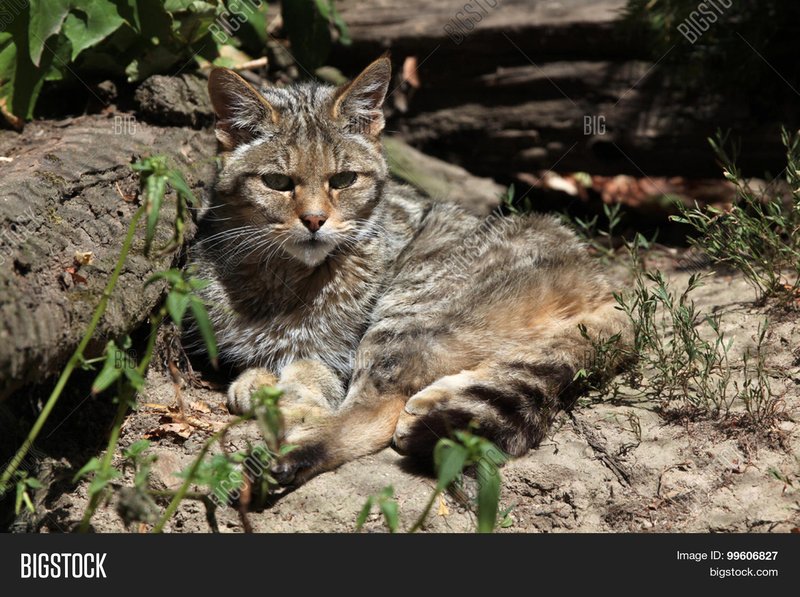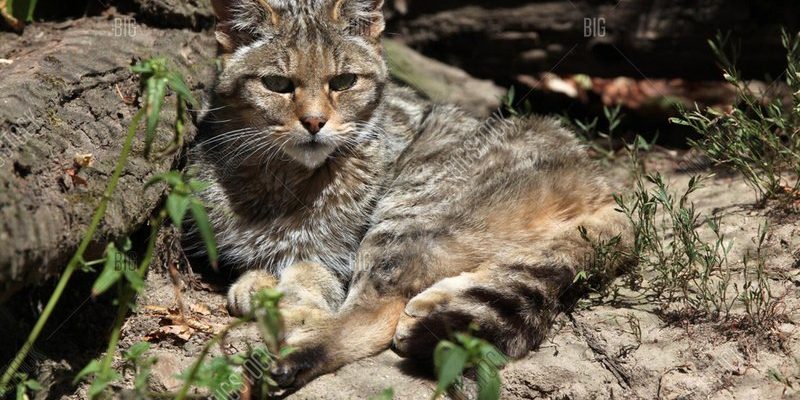
The European Wildcat is a fascinating creature that roams the forests and grasslands of Europe and parts of Asia. Imagine a domestic cat, but with a wild twist—these cats are built for survival in the wilderness, sporting a thicker coat, longer legs, and a more robust body. They are not just cute and furry; they play a crucial role in their ecosystems as hunters and prey. So, let’s delve deeper into what makes the European Wildcat an intriguing species!
You might be surprised to learn that these cats are quite different from the fluffy pets we know. They are masterful hunters, perfectly adapted for life in dense forests. Their coats are a beautiful mix of gray and brown, allowing them to blend seamlessly into their surroundings. It’s almost as if they were designed by nature to be elusive, providing them an edge in avoiding predators while stalking their own prey.
Physical Characteristics
The physical makeup of the European Wildcat is truly remarkable. Adult wildcats typically weigh between 4.5 and 9 kg (10 to 20 pounds), with a body length of approximately 60 to 75 cm (24 to 30 inches), making them slightly larger than domestic cats. Their tails are bushy and can measure up to 30 cm, adorned with black rings and a characteristic black tip. Intrigued yet? These features are not just for show; they serve important roles in communication and balance.
One of the first things you might notice is their striking facial markings. They have distinctive dark stripes running from their eyes down the side of their face, which not only enhances their beauty but also helps them communicate with other wildcats. Their ears are pointed and adorned with tufts of fur—a trait that helps with sound directionality, making them exceptional hunters.
Habitat and Distribution
The European Wildcat is primarily found in forested areas, grasslands, and remote mountainous regions. They prefer habitats that provide ample cover for stalking prey and are typically found in regions with a good mix of open and wooded areas. You can spot them across various parts of Europe—from the lush forests of Germany to the rugged highlands of Scotland. Their adaptability allows them to thrive in different environments, making their range quite extensive.
They are solitary animals, usually marking and defending their territories from other felines. A male may cover a territory of up to 40 square kilometers, while females typically stick to a smaller area. Although these wildcats prefer low-density human regions, they can sometimes be spotted near agricultural land, where they hunt rodents and other small creatures. You might find it interesting that their territories are often marked with scratches on trees or by secreting scents—almost like nature’s own form of graffiti!
Diet and Hunting Behavior
When it comes to food, the European Wildcat is an opportunistic hunter. Their diet mainly consists of small mammals, including rabbits, mice, and voles, but they are also known to eat birds and insects when the opportunity arises. They are nocturnal creatures, which means they do most of their hunting at night, relying on their sharp senses to find prey in the darkness. Imagine sneaking through the woods under the cover of night, silently stalking your next meal—that’s exactly what these wildcats do.
Hunting is more than just a necessity for these cats; it’s an art form. The European Wildcat uses its excellent hearing and keen eyesight to detect movement. Once they’ve spotted potential prey, they will stalk it carefully, often waiting in stillness until the right moment to pounce. This combination of patience and speed is what makes them such effective predators. In fact, you might be surprised to learn that they can reach speeds of up to 48 km/h (30 mph) in short bursts when chasing down their dinner!
Reproduction and Lifespan
In the wild, the European Wildcat typically breeds once a year, with the birthing season occurring in spring. After a gestation period of about 63 days, the female usually gives birth to a litter of 2 to 5 kittens. These kittens are born blind and rely heavily on their mother for warmth and nourishment during their early weeks. If you’ve ever witnessed a mother cat nurturing her young, you know just how tender and protective they can be, and the wildcat is no different.
As the kittens grow, they begin to explore their surroundings, learning crucial survival skills from their mother. By the time they are about six months old, they become independent hunters. In the wild, European Wildcats can live up to 10–12 years, although those in captivity may live longer due to consistent food and medical care. It’s fascinating to think about how their wild upbringing shapes their instincts and behaviors; every play session and hunting lesson is preparation for a life lived on their own.
Conservation Status
Sadly, the European Wildcat faces several threats that put its future at risk. Habitat loss due to logging, farming, and urban development has had a significant impact on their population. Additionally, interbreeding with domestic cats poses a challenge, as it dilutes their genetic distinctiveness and reduces their adaptability. Conservation efforts are underway to protect these wildcats, including habitat restoration and public awareness campaigns to prevent further hybridization.
It’s essential to remember that every species plays a role in its ecosystem. The European Wildcat helps control rodent populations, serving as a natural pest controller. Their decline could lead to imbalances in their environment. To ensure their future, various organizations are working tirelessly to monitor populations and educate locals about the importance of preserving these elusive felines. Supporting these initiatives can make a tremendous difference!
Interesting Facts
| Scientific Name: | Felis silvestris |
| Size: | 60–75 cm long |
| Weight: | 4.5–9 kg |
| Diet: | Rodents, birds, insects |
| Lifespan: | 10–12 years in the wild |
| Speed: | Up to 48 km/h |
| Habitat: | Forests, grasslands, mountains |
The European Wildcat is a striking example of untamed beauty and resilience in the wild. Their unique adaptations and behaviors remind us of the importance of protecting our natural world and its inhabitants. As we learn about these remarkable creatures, we become more aware of our role in their conservation.
Next time you hear a rustle in the brush or catch a glimpse of a beautiful feline form darting through the trees, remember this wildcat and the delicate balance it helps maintain in its ecosystem. With continued efforts in conservation, we can hope to see these majestic animals thriving in the wild for generations to come.
FAQ
What does the European Wildcat look like?
The European Wildcat is similar in appearance to a domestic cat but generally larger and more muscular. They have a thicker, grayish-brown coat with dark stripes and markings that help them blend into their forest surroundings. Their tails are bushy with distinctive black rings, and they possess expressive facial features that aid in communication.
Where can I find European Wildcats?
You can find European Wildcats across many parts of Europe and into western Asia, primarily in forested areas, grasslands, and mountainous regions. They thrive in habitats that provide cover for hunting, so they are often spotted in remote and less populated areas, away from urban development.
How do European Wildcats communicate?
European Wildcats communicate through various methods, including vocalizations, body language, and scent marking. They might growl or hiss to warn off intruders, while their scent markings on trees and bushes signal their territory to others. Additionally, their facial expressions and posture can convey a range of emotions, from aggression to submission.
Are European Wildcats endangered?
While the European Wildcat is not classified as endangered, its population faces threats from habitat loss and interbreeding with domestic cats. Conservation efforts are in place to monitor their numbers and promote habitat protection to ensure their survival in the wild.
What do European Wildcats eat?
European Wildcats are carnivorous, with a diet that primarily consists of small mammals, such as rabbits, hares, and rodents. They are opportunistic hunters and will also consume birds and insects when food is scarce. Their hunting methods involve stealth and patience, making them effective predators.
How long do European Wildcat kittens stay with their mother?
European Wildcat kittens typically stay with their mother for about six months, during which time they learn essential survival skills, including hunting. After this period, the young cats become independent and start to establish their territories, but they may occasionally return to their mother for a short time.
What is the difference between a European Wildcat and a domestic cat?
The main differences between European Wildcats and domestic cats lie in their size, behavior, and habitat. Wildcats are generally larger, more muscular, and have thicker fur. They are more solitary and territorial than domestic cats and are adapted for hunting and survival in the wild. Domestic cats, on the other hand, have been bred for companionship and tend to rely more on humans.
Can European Wildcats be kept as pets?
It is not recommended to keep European Wildcats as pets. They are wild animals with specific needs that are difficult to meet in a domestic setting. They display natural hunting instincts and territorial behavior, making them unsuitable companions for typical households. Instead, it’s best to appreciate them in their natural environment.
How can I help conserve European Wildcats?
You can contribute to the conservation of European Wildcats by supporting organizations that work toward habitat protection and species monitoring. Educating others about the importance of these animals and advocating for wildlife-friendly practices can also make a significant difference. Avoiding the introduction of domestic cats into wild populations is crucial for their genetic integrity.
Are European Wildcats social animals?
No, European Wildcats are typically solitary animals, except during mating season or when mothers are raising their kittens. They establish and defend their territories, which can overlap with others but are generally marked to avoid confrontation. Their solitary nature is essential for hunting, as they rely on stealth and camouflage rather than group tactics.
How do European Wildcats adapt to their environment?
European Wildcats have adapted to their environments through various physical and behavioral traits. Their thick fur provides insulation in cold climates, while their hunting techniques allow them to survive in diverse habitats. They can also modify their feeding habits based on the availability of prey, demonstrating remarkable flexibility in their diets and behavior.

